Artistic Director: Mareen Alburg Duncker
Förderschule “Astrid Lindgren” in Halle (Saale)
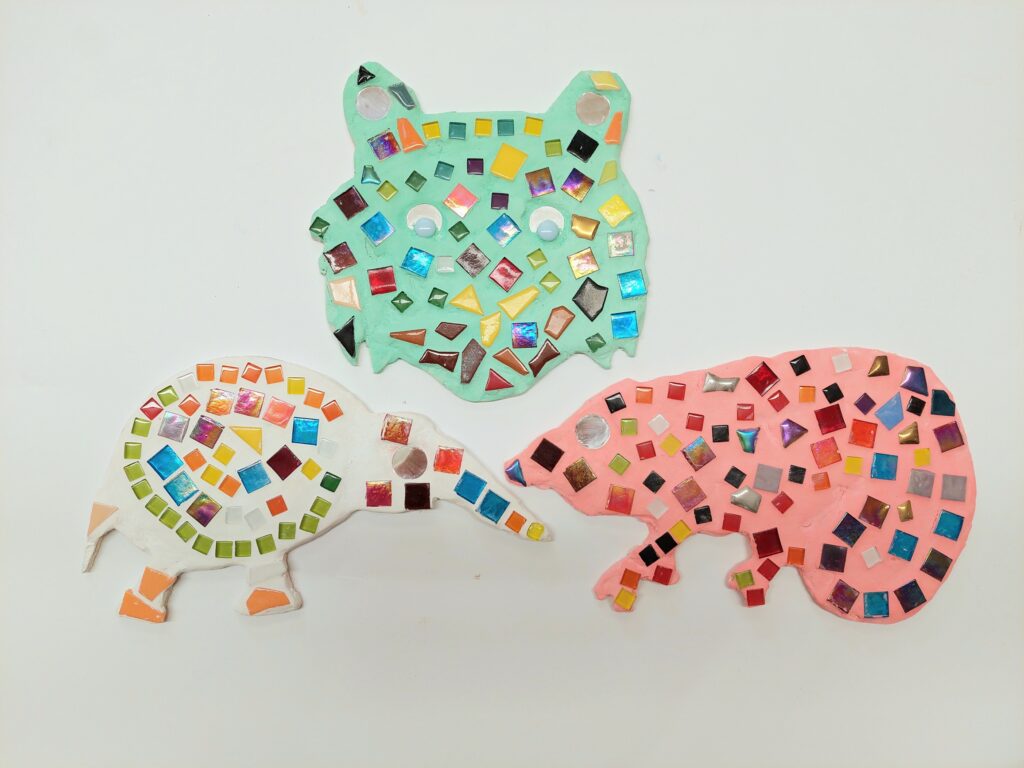
The children drew fantastic animals and plants on paper on the theme of the URWALD and colored them in. Using this template, the children sawed out the shapes from poplar wood panels. The mosaic tiles were then selected, placed and glued on, the gaps filled with grout and then cleaned and polished.
Unique mosaic tiles were created. Each child worked with patience and concentration according to their own abilities and was very proud of their own mosaic.
Artistic director: Claudia Baugut
Regenbogenschule in Landsberg

THEME: AMULET AND TALISMAN
Designing a piece of jewelry in the form of a pendant that can be worn as a lucky charm with a personal reference. I showed examples from the plant and animal kingdoms, signs and symbols, gave suggestions from art history – there was a lot of attention!
The pupils first drew. They then shaped, dried and colored their own papier-mâché. Surprisingly numerous and individual results and works were created – according to the different skills of the special needs pupils.
Artistic director: Anne Baumann
Salbke elementary school in Magdeburg
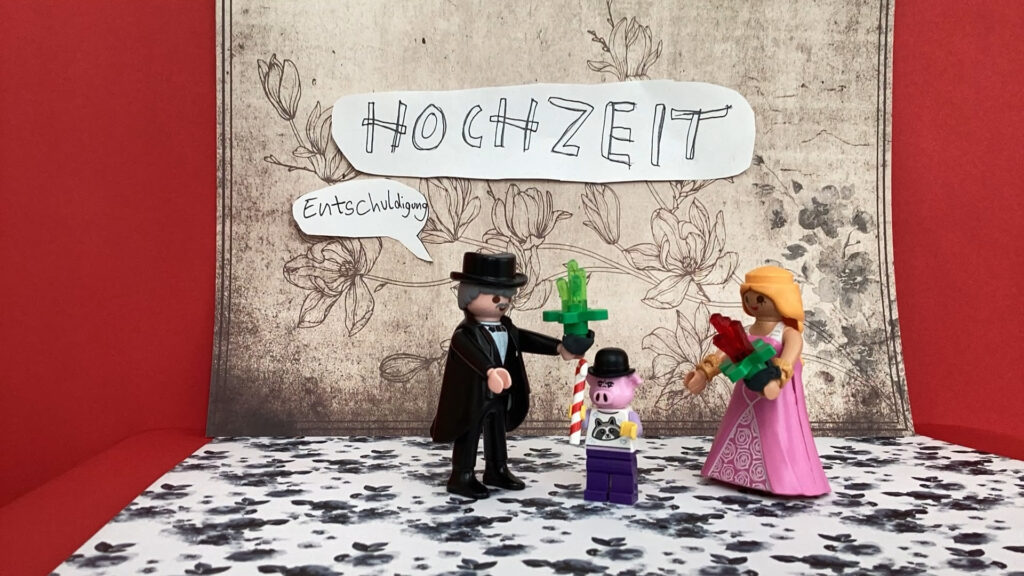
As part of a project week, the children in class 4a created their own animated films using the school’s own iPads and the free “Stop Motion Studio” app. Each team, consisting of 2-3 children, came up with a story at the start of the project and recorded it on a storyboard.
And then the teams got to work: they prepared the characters they had brought along for the film shoot, designed elaborate film sets and props, devised dialogues and worked with concentration and enthusiasm on the realization of their story. At the end of the project, there was a big screening of all the films created.
By animating the individual images, the children set their ideas in motion, became artistically active and used the technique to express their creativity. In this way, the stop-motion film project makes an important contribution not only to cultural education, but also to the children’s self-efficacy and personal development.
Artistic director: Michela Benedan
Freie Schule Riesenklein in Halle (Saale)

The school project was implemented in the form of a weekly working group. The children mainly worked with two colors of clay: a black and a light mass.
We were able to try out many different techniques: the cutting of clay blocks that “hid” a drawing inside with the black mass, a marble technique and a monotype technique with engobes. It was about an interface between graphic and sculptural work with clay.
Artistic director: Christiane Budig
Hohenturm Primary School in Landsberg
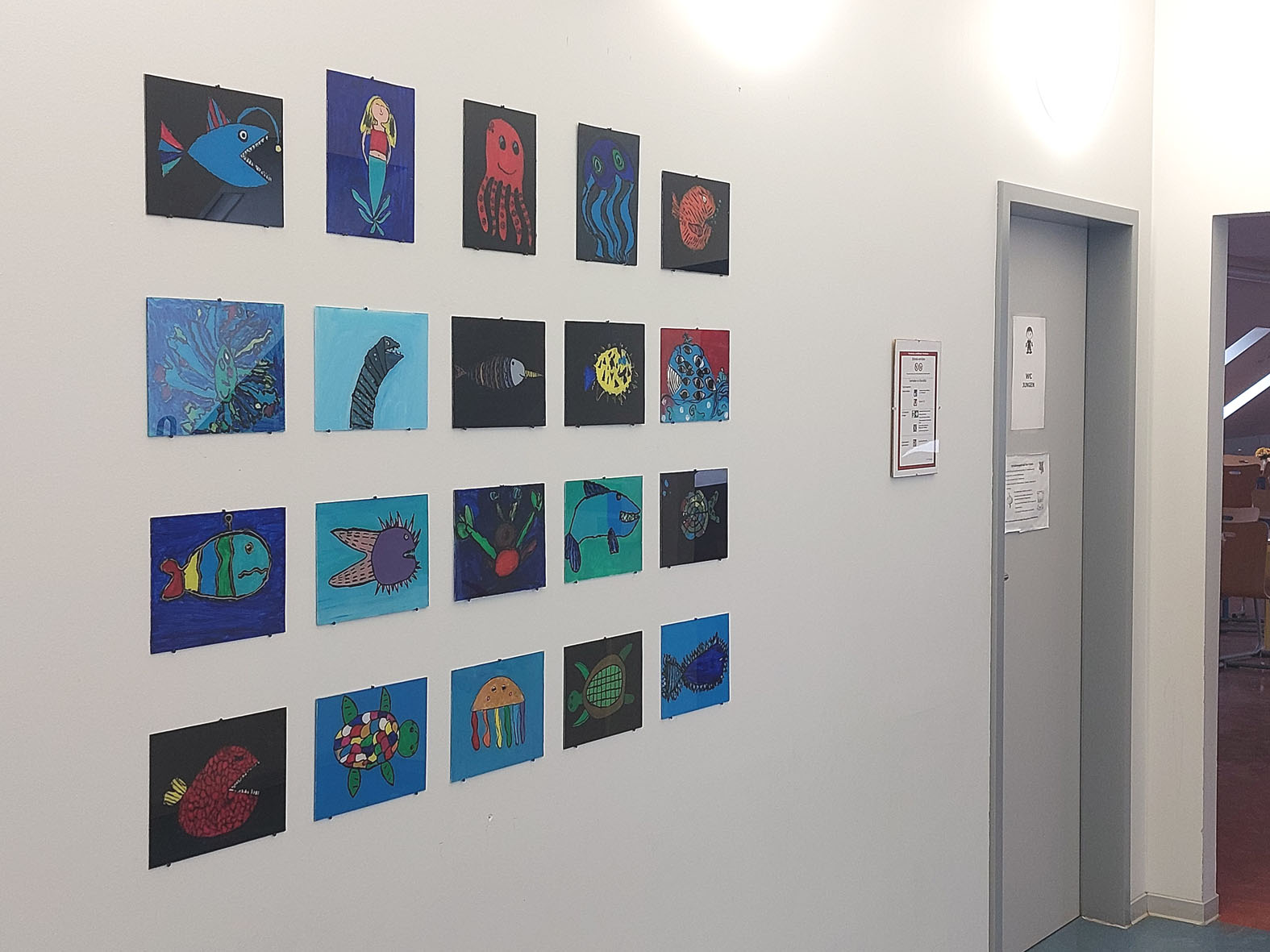
The 4th grade pupils tried out the technique of reverse glass painting as part of the project.
For this they needed acrylic paint and Plexiglas. With this technique, in contrast to the adding painting method on paper, the first layer of paint is in the foreground and the following layers are staggered behind it. It can therefore be described as a subtracting painting technique. This painting method requires careful planning, patience while the paint dries and concentration. Due to the transparency of the painting ground, the painting process can be checked at any time and corrected if necessary.
The pupils used ink blowing to find motifs. They created fantastic creatures that they later used as templates for their sketches. When brainstorming, we agreed on creatures under water. Over the course of the project, we created a large number of fantastic underwater creatures, a selection of which we permanently installed in the school’s corridor area. With the technical experience gained, all the pupils created a second reverse glass painting with a free choice of motif, which they took home with them.
Artistic director: G. Burkard Büttner
Primary school: “Sebastian Kneipp” in Bad Schmiedeberg
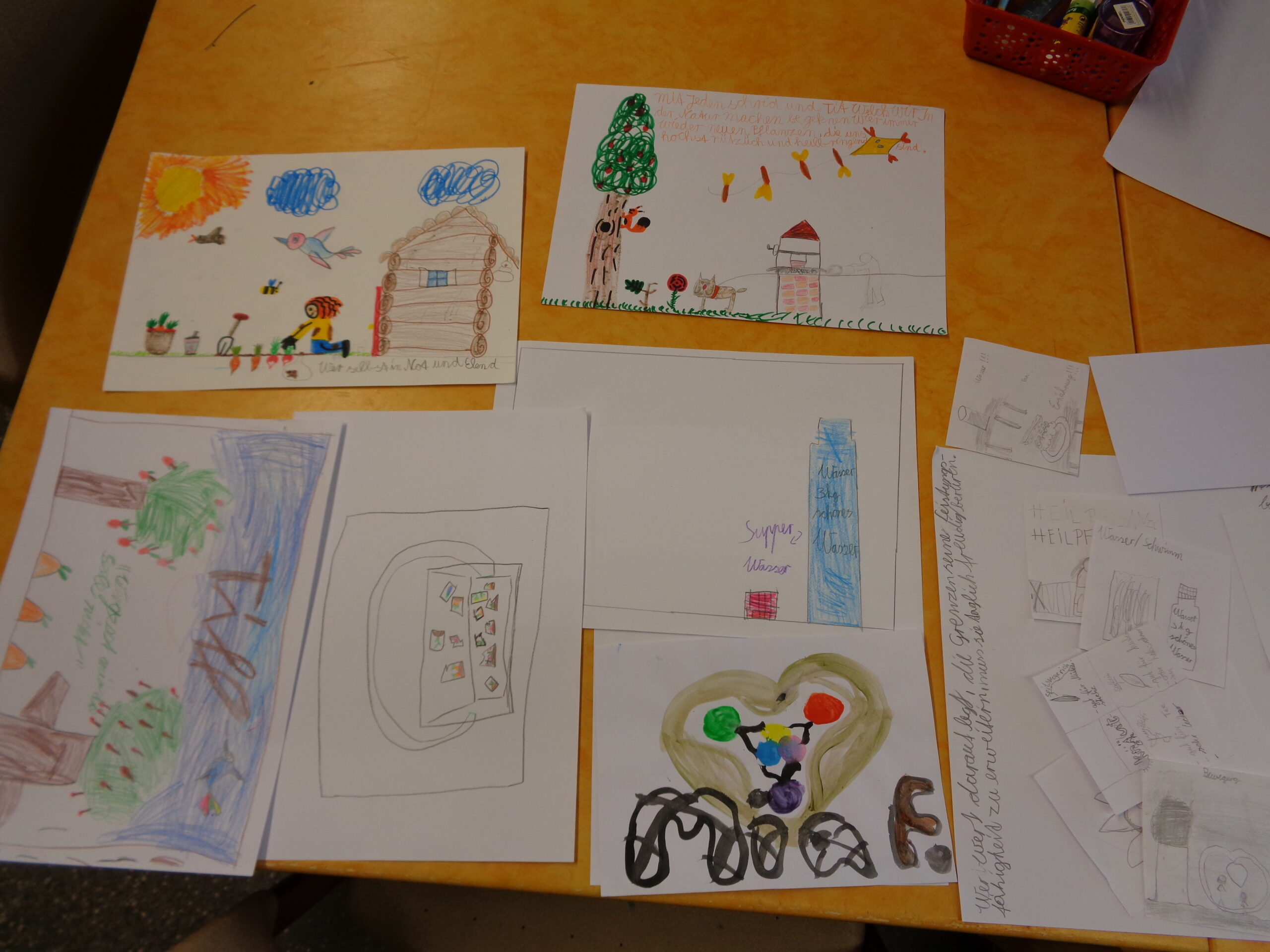
The children looked at quotes in the form of sayings by Sebastian Kneipp and the 5 subject areas/pillars (exercise, medicinal herbs, water, nutrition, balance) of Kneipp’s teachings. They developed an individual, colorful drawing based on their interests and relationships. The drawings were then combined with the individually selected texts, whereby the aim was also to design the writing in form, color and arrangement according to the image structure.
The children developed their drawings on the basis of an emotional interest in the respective topics and had various ideas and inspirations from the quotes by Sebastian Kneipp. In this way, each child found an individual and emotional approach to the Kneipp art project. Independent and very individual picture-text combinations were created, depending on the children’s preferences and expressions.
Each child was able to realize a design close to the model of nature or rather in the expressiveness of the color and its symbolism in combination with the writing of the quotations according to his or her individual point of view and preference.
Artistic director: Sabine Brauns
Primary school association “An der Stadtmauer” in Zerbst
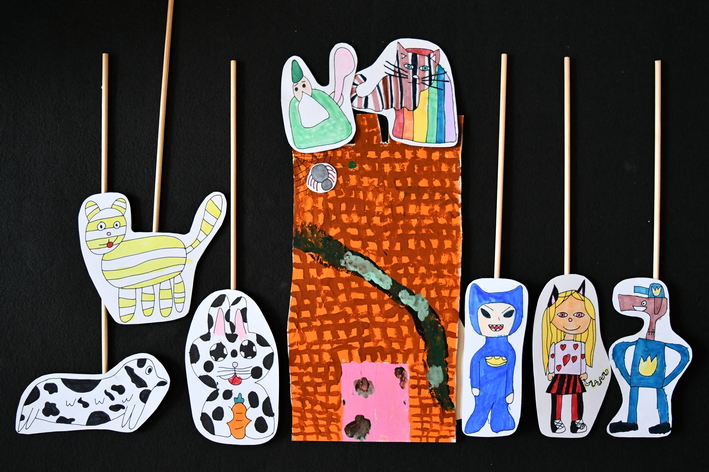
Under the motto “Stories you can touch”, 12 pupils in grades 2 – 4 worked together to develop their own fantasy story. Over several months, they playfully devised an exciting plot and painted protagonists and backdrops.
The story “The Magical World” tells the tale of three friends who are transported to a distant kingdom through a transformation and have to endure many adventures.
The highlight of the project was the performance in the form of a table theater in front of an audience.
Artistic director: Anne Deuter
After-school care center at Nietleben elementary school
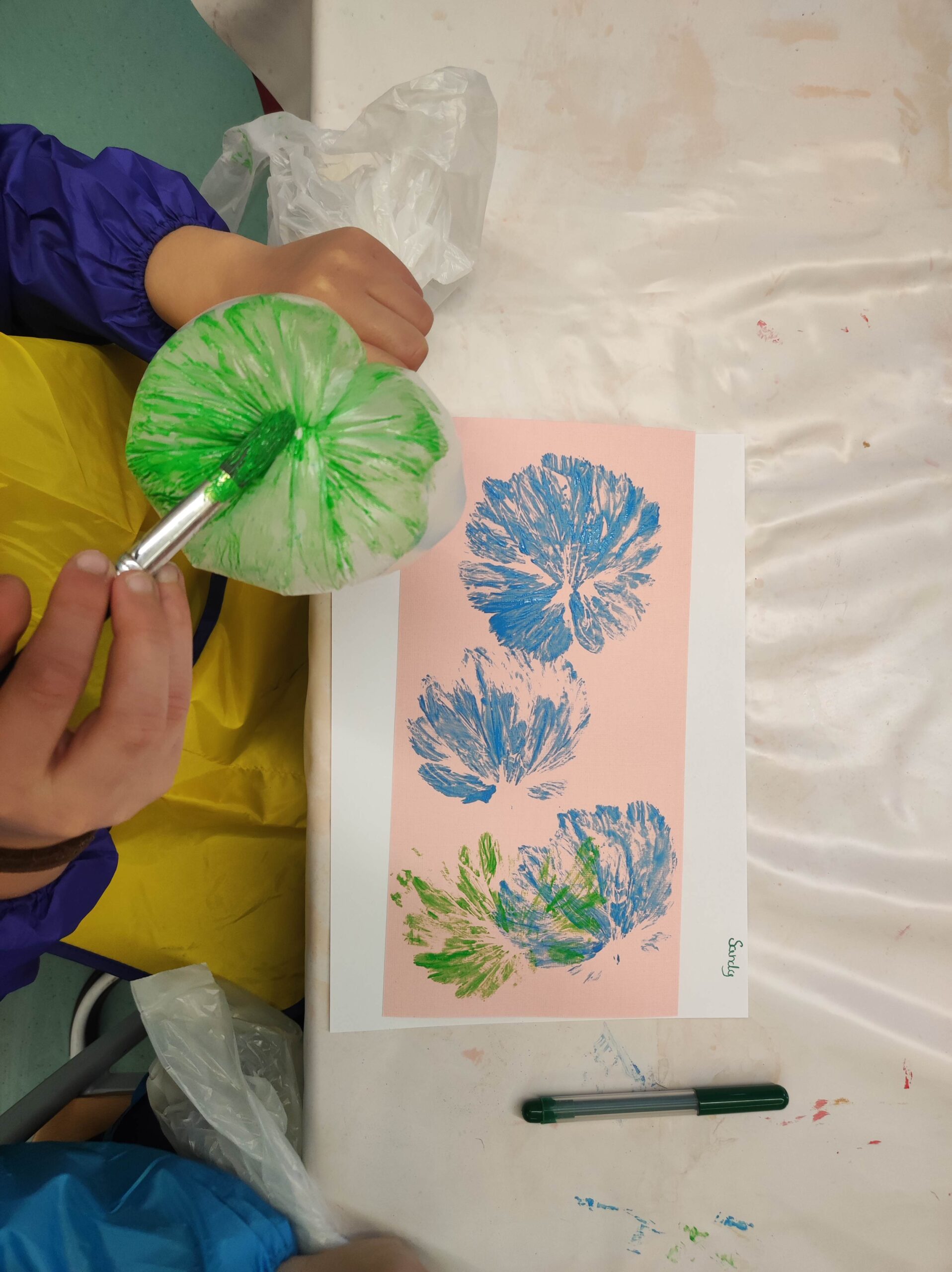
During the winter vacations, 16 pupils from first to fourth grade at Nietleben elementary school tried their hand at bookmaking in a variety of ways. Colorful and unique books were created with the help of garbage bag balls of different sizes, which were painted to conjure up flowers on the paper.
The magic didn’t stop there! Using a piece of plasticine, the children went in search of structures and surfaces in the school. What they found was molded, printed and finally bound in a school exercise book. Finally, everyone found the magic in marbling with shaving foam.
Artistic director: Mariella Gänsewig
Bildungshaus Riesenklein in Halle (Saale)
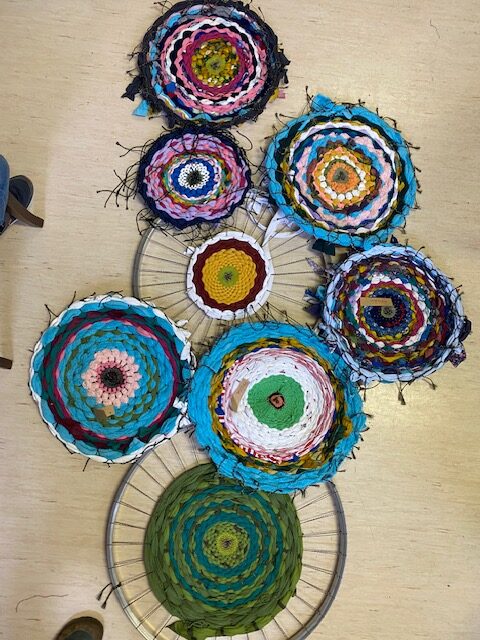
The project took place with children from the first and second grades. The participants experimented with the topic of “thread crosses”. The children acquired basic knowledge of weaving in a playful way. By simply crossing threads, they created colorful kites, dream catchers and wall hangings.
In a further step, the children learned how to circular weave. First they practiced on cardboard frames, later the young artists wove on frames made from old bicycle rims. New, colorful carpets were created from recycled old textiles.
A highlight of the project was the visit to the Teuscher weaving mill. Here, the participants were able to gain an insight into industrial production, work on large looms themselves and experience the technology at first hand.
Artistic director: Micha Gebhardt
IGS Am Planetarium in Halle (Saale)

The pupils artistically explored the theme of “Togetherness”. Based on the theme, the group of pupils developed individual topics for each project day, “Principle of Coincidence”, “City and Nature”, “Animals and Humans” and “Life in Colonies”, which were worked on artistically using different techniques and materials.
The results were prints in relief and intaglio printing and sculptural works made of wire and papier-mâché.
Artistic director: Katharina Günther
Protestant elementary school “Martin Luther” in Hettstedt

People have been wearing masks since time immemorial. Two 4th graders immersed themselves in the mysterious, magical world of masks. First, the children developed their own ideas through drawing.
What expression should it have? What does it do to me when I put on a mask?
They used newspaper, foil, clay, egg carton and aluminum foil to build a basic body, which was then covered with plaster bandages. After drying, the masks could be removed and colored.
Artistic director: Laura Hanisch
“Ulrich vun Hutten” elementary school in Halle (Saale)
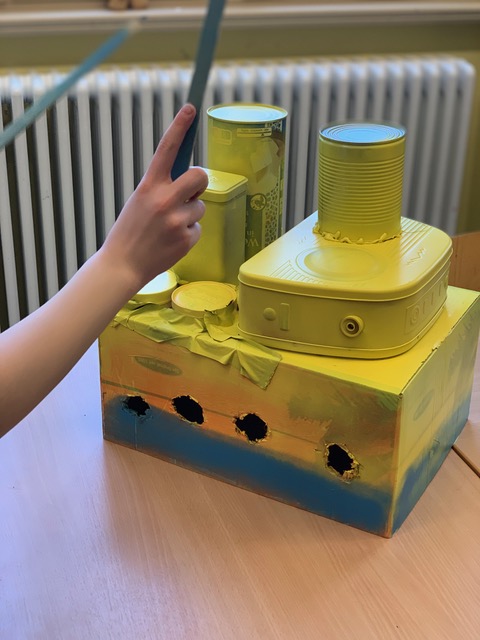
In an exciting instrument-making workshop, the children built their own musical instruments from recycled materials to set weather phenomena to music.
Plastic bottles, cans, rubber bands and pieces of wood were used to make creative drums, wind instruments and rattles. The focus was on sustainability and the promotion of teamwork and creativity as well as the sharpening of all senses. At the end of the workshop, the children were able to proudly present their self-made instruments.
Artistic director: Heinrich Herbrügger
Jeetzeschule Salzwedel

For the art project, the two 9th grade classes of the Jeetzeschule set up shop in the Kunsthaus Salzwedel and went deep into the creative process.
It was the Tanaro and San River classes who created artistic works in the fields of collage, photography, painting and objects under the working title “Me in the world”. The final title of the art project “BE DIFFERENT! you only live once” was developed and chosen by the pupils themselves in a democratic process.
Artistic director: Jan Herzog
Oppin Primary School
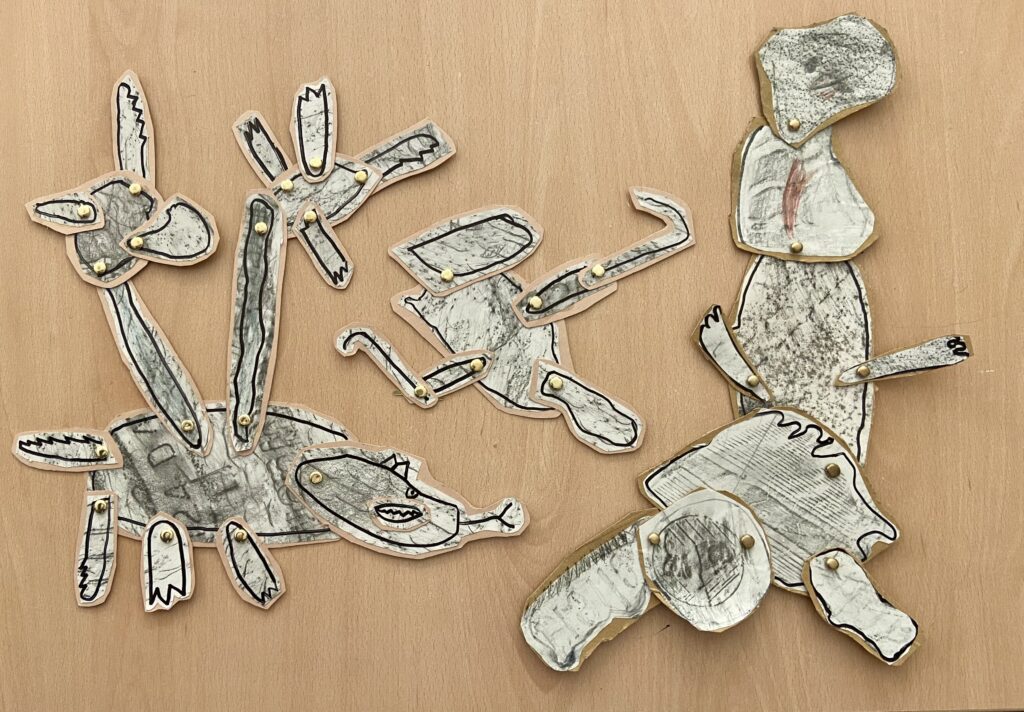
The beginning: Frottage in the schoolyard, alternating with classes one and two of Oppin elementary school. Finding the special features on the familiar site.
Then it’s about finding forms in the frottages – the form-finding process proves to be a challenge.
Imagination, precise vision… The shapes are cut out, glued to cardboard, then cut out again and drilled, and provided with joints. None of the resulting “articulated dolls” are the same.
Artistic Director: Julia Himmelmann
Secondary School Bad Schmiedeberg
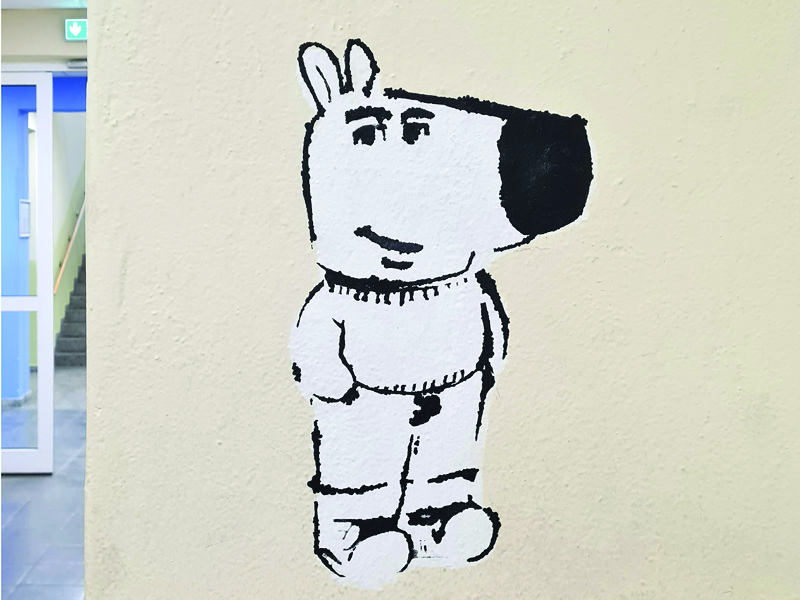
In the project, the pupils immersed themselves in the world of street art. In a playful way, they developed motifs that refer to places in the school building. The focus was on the question of what they wanted to tell at this location.
Using freely drawn pictures or photo editing on the computer, they designed stencils that were then transferred to the walls of the school corridors. The resulting figures, lettering and objects now intervene in the space. They surprise, tell stories and point to the unnoticed and the possible.
Artistic director: Barbara Hoeft
Otto-Boye elementary school in Haldensleben

“My fantasy animal”
As part of a working group, material prints were made with 12 pupils in grades 3 and 4.
After looking together at works by Kurt Halbritter, we came up with our first ideas for imaginary creatures that we had devised ourselves. We then tried out how different materials glued to cardboard create different structures when printed. As a result, the children glued corrugated cardboard, smooth cardboard or wool and then rolled these in with printing ink and rubbed them off.
Some of the print results surprised the pupils.
Artistic director: Silke Hönig
Salzmünde Primary School

The art project included a workshop on the production of natural paint for nineteen pupils from a third grade class. Centuries-old knowledge of color extraction from seasonally available plants from nature was taught. Over 20 different shades of color were obtained. In addition to numerous color experiments, pictures were created on the theme of the (garden) jungle. Each child developed their own ideas.
The pupils collaged onto large-format backgrounds using collage material they had previously designed themselves. This was created and cut out using plant prints, plant-dyed tissue paper and painted animals. The backgrounds were blotted, sprayed, washed, scratched or watercolored tone on tone. At the same time as enjoying painting, the children experienced the creation and modification of collage pictures by adding, moving and removing picture elements.
Artistic director: Dorit Kempe
J.G.-Borlach-Gesamtschule in Bad Dürrenberg

The pupils in year 10 were able to try their hand at making a book or portfolio over a total of three days.
These were then designed by the pupils with a collage on the theme of landscape. After a brief introduction to the topic of collages, the pupils had the opportunity to implement their own ideas on this topic using various materials such as magazines, calendar pages, textiles, ribbons and threads.
The students were able to take photos with their cell phones to document the process of creating their collage and try out different design options. The result was many imaginative and magical landscapes.
Artistic director: Wiebke Kirchner
Förderschule Lernzentrum Halle-Neustadt
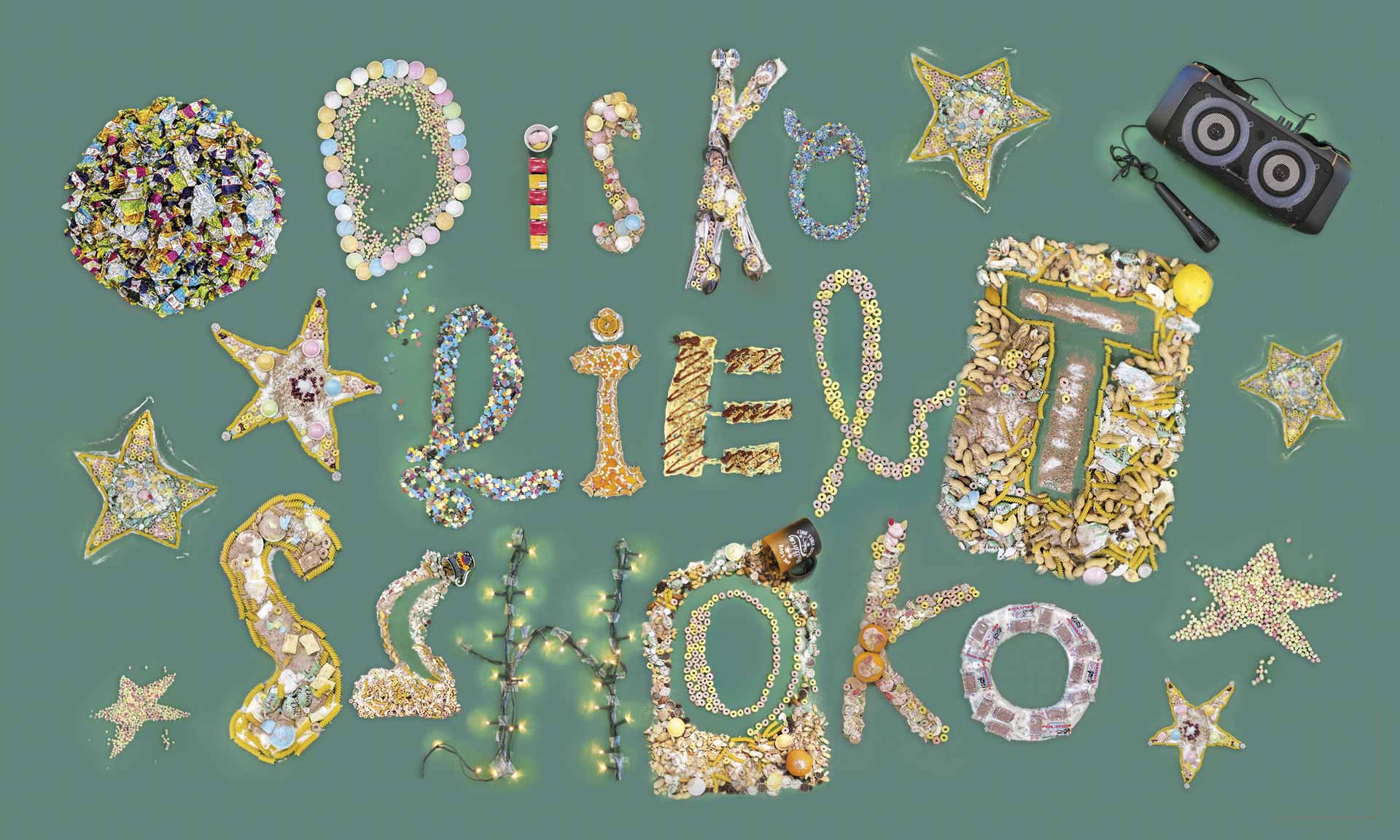
It was colorful, delicious and crackling in the student café of the Halle-Neustadt special needs school! Over the course of three project days, class 5a explored the artistic potential of their favorite snacks and enlarged them several times to create a banner print on the wall.
Under the guidance of artist Wiebke Kirchner, the children developed their own text and motif ideas for the wall design during the project days, which they then realized as playful assemblages of food, sweets and kitchen accessories.
The results were photographed and printed on a 2.5 x 3 meter textile banner, which now adorns the school café. A work of art that whets the appetite!
Artistic director: Thomas Kober
“Albrecht Dürer” elementary school in Halle (Saale)

Over three days, 22 third-graders designed a book on the subject of animals. While one half wrote texts, the other learned about the monotype printing technique.
First, they sketched animals in pencil, printed monochrome and multicolored motifs and, on the third day, designed a cover with colored pencils and animal and letter stickers.
The covers and pages were punched with prickle needles and bound by hand using Japanese book block stitching, creating individual books for each child.
Artistic director: Juliette Kolberg
“Lebensweg” special school in Bernburg

“Figure – Vessel” Clay was chosen as the material for this project as it can be used very intuitively. After an introduction to the technique and properties of the material, everyone was able to approach this material individually.
All participants were given the opportunity and encouragement to associate the shape of a vessel with a figure. They were able to explore their own abilities in an imaginative three-dimensional creation process and gain new, self-esteem-boosting experiences.
Artistic director: Alexander Lech
“Förderschule am Heidetor” in Zerbst
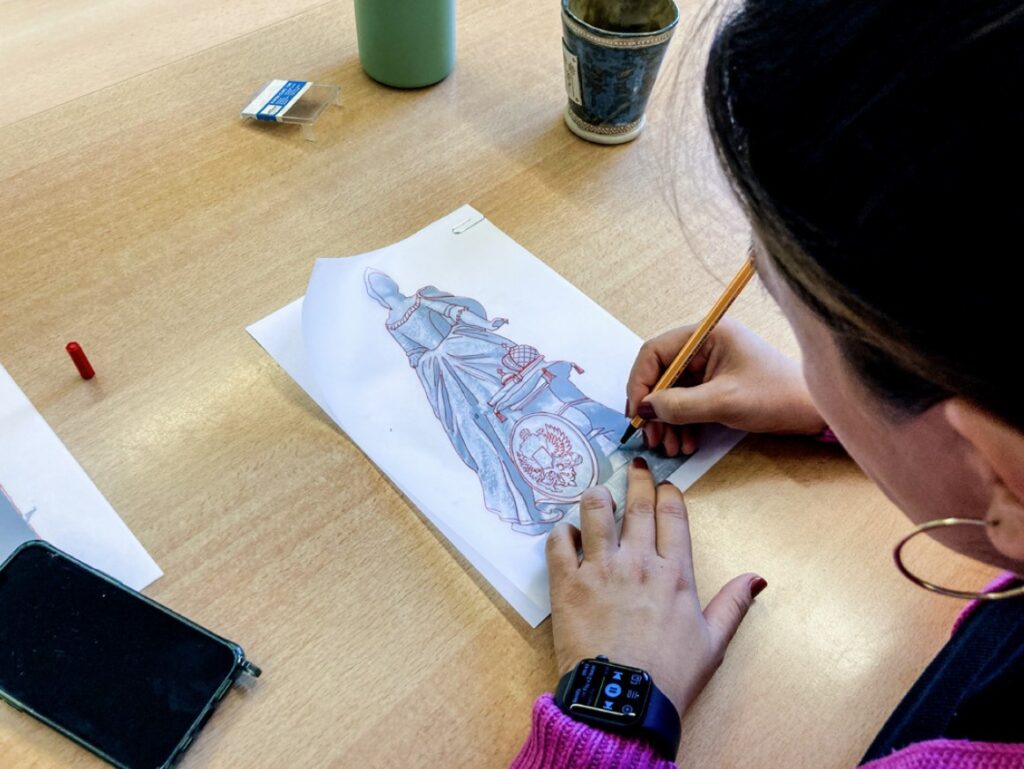
In this workshop, the participating students explored the city center and photographed historical buildings such as the castle, the city church and the Heidetor.
The photos were then copied, combined into collages and printed on mugs. The project not only strengthened the pupils’ creativity but also their awareness of the city’s history.
The mugs are also a creative contribution to this year’s Christmas market at the special school.
Artistic director: Thomas Leibe
Hugo Kükelhaus special school in Magdeburg

Together with children from the “Hugo Kükelhaus” special school in Magdeburg, Halle-based artist Thomas Leibe has made the basic emotions of fear, anger, joy, disgust and sadness visible. Emotional communication was combined with visual language. But what color is disgust? What form does anger take? What symbols are attributes of joy? What structure does fear have and how colorful is sadness? We find answers to these questions in the large-format canvas collages.
Artistic director: ilka Leukefeld
Förderschule S “R.-Lakomy” in Halberstadt
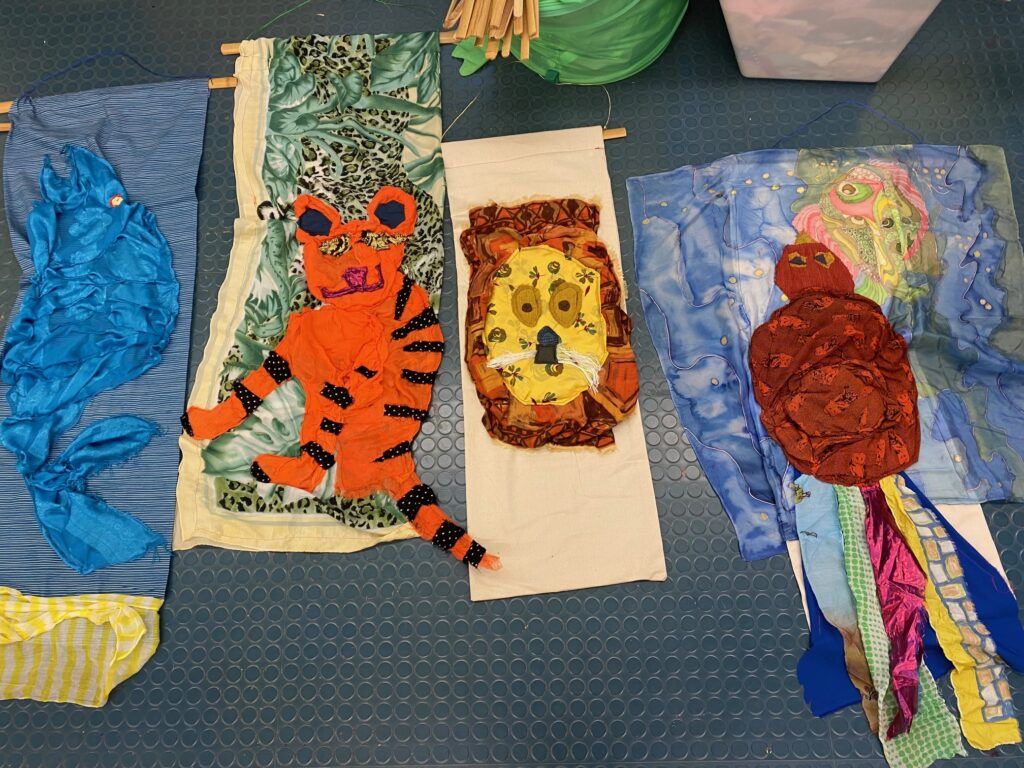
“What do I write on my banner?”
A total of 16 children each made an appliqué of an endangered animal from fabric. They created, for example, a snake, crocodiles, a niel horse, a panda bear, an elephant, an extremely long giraffe, a blue butterfly, a tiger, a fish, a seahorse with a yellow belly, a llama with a red head – there were no limits to their imagination.
As the school purchased three sewing machines, we were able to sew the flags intended for the schoolyard from fabrics, recycled clothing, cloth and buttons. The colorful flags are about 40 x 100 cm, some are much wider and longer. Recycled wide bamboo poles and a matching colored wire are used to hang the flags.
Artistic Director: Annekatrin Müller
“J.-G.-Borlach” Community School in Bad Dürrenberg
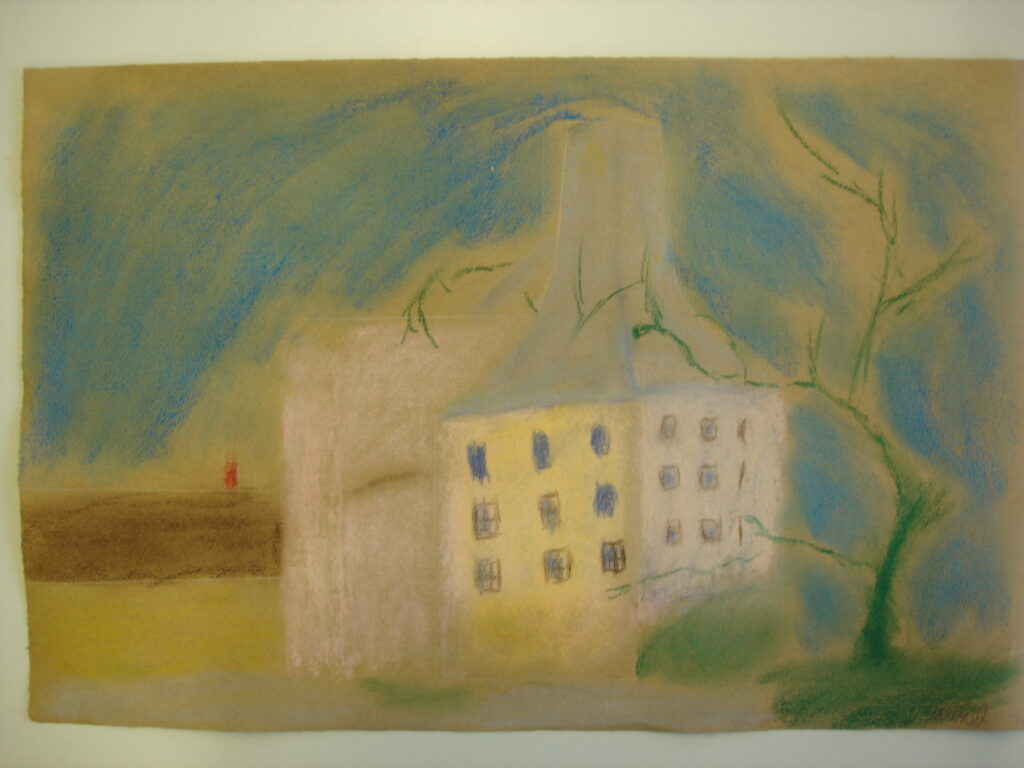
Year 10 pupils in Bad Dürrenberg drew landscapes with architecture based on nature. Particular emphasis was placed on capturing perspective.
The resulting sketches were to be combined with architecture and landscapes from all over the world based on the imagination and inspired by surreal works of art. The resulting sketches were then transferred to a larger format using pastels.
Artistic director: Marion Münzberg
“An der Heide” elementary school in Dessau-Kochstedt

The 26 pupils in Year 2 worked on 4 project days on the topic of “My painted story”. The aim was to tell their own story in pictures and summarize it in simple books.
In the first part of the project, the pupils practiced skills (folding, drawing, working with templates, cutting) to produce simple book covers. In the next step, they developed ideas for a three-page leporello from their own detailed stories. The pupils learned how to abstract their idea, draw the adhesive edge, paint it to fill the format, cut it out and complete the fanfold book with pages and book cover.
Finally, each pupil developed a pop-up card as another way of telling a (Christmas) story. The idea of an oversized Advent calendar filled with pictures and wishes, to be admired in the school corridor during Advent, was spontaneously born.
Artistic director: Christian Nebel
Grundschule “G.-E.-Lessing” Halle (Saale)
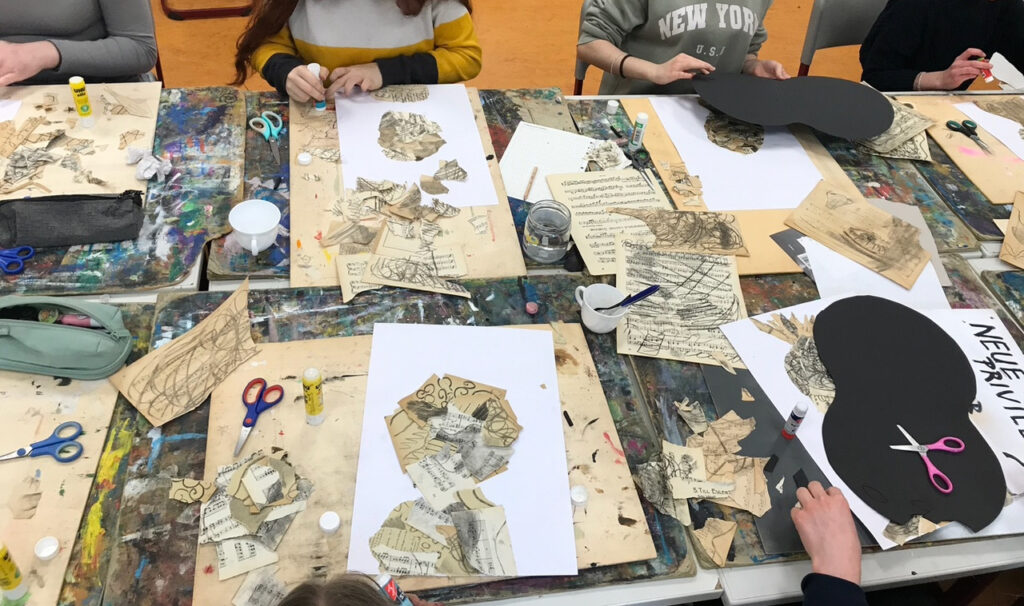
The aim of the “Nature study for children” project was to focus on the beauty and diversity of nature. Through direct observation and artistic work using traditional techniques such as drawing and frottage, the children’s senses were sharpened and their connection to nature encouraged in a playful way.
The project was not only intended to teach them technical skills, but also to strengthen their creativity, fine motor skills and sensitivity to their environment.
The project was divided into four practical units, supplemented by preparation and follow-up time. The activities mainly took place outdoors to bring the children into direct contact with nature. The practical sessions were accompanied by individual and group discussions, which provided space for reflection and inspiration.
Artistic director: Tobias Nerger
Burg Gymnasium in Wettin
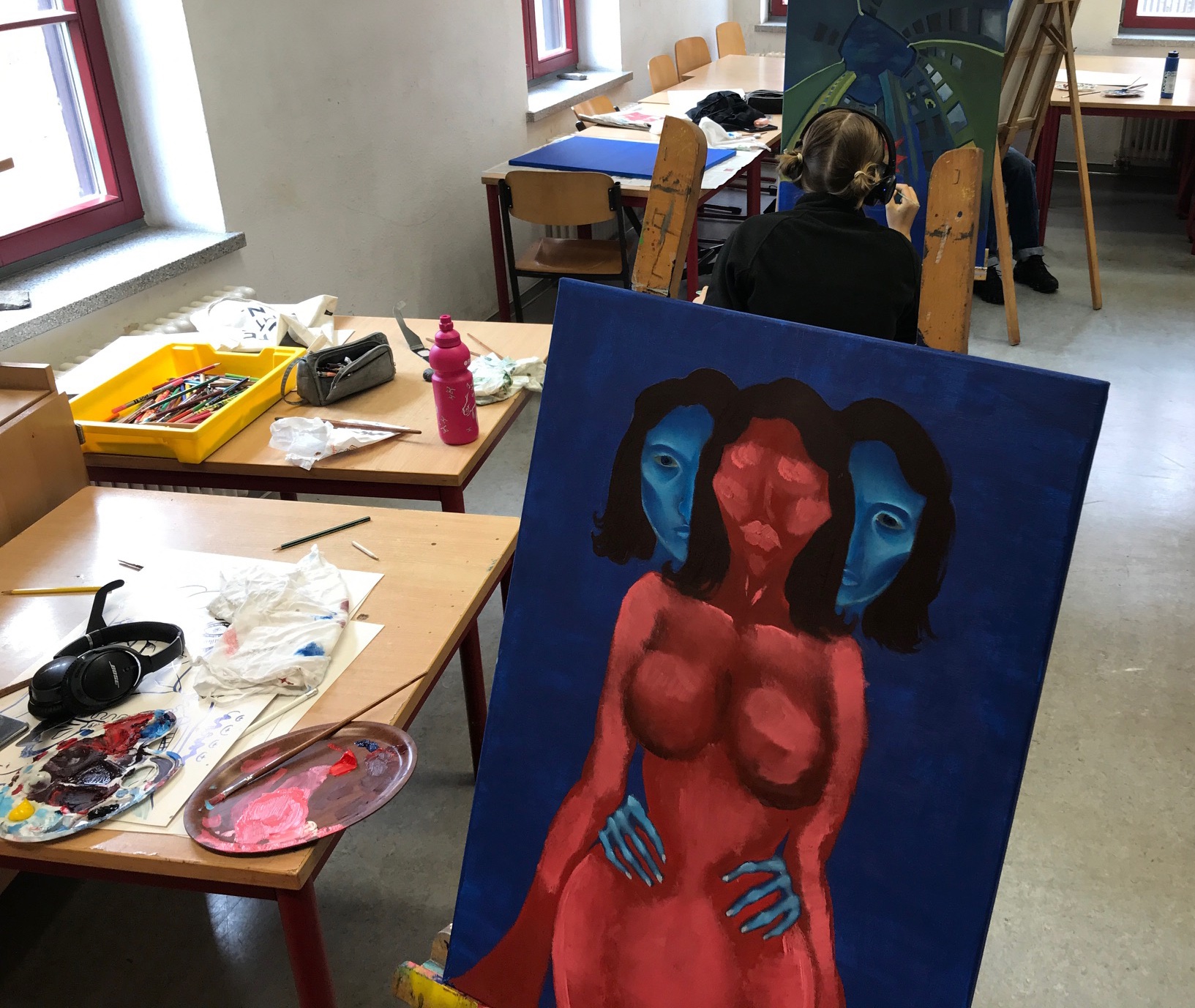
Using oil paints on canvas, the pupils embarked on a painterly journey into the world of stereoscopy, which was realized using 3D glasses in the ChromaDepth process.
First, the pupils were given an introduction to the basics of the painting technique, whereby the physical wavelengths of the colors create a spatial arrangement. This was followed by brainstorming and sketching on paper/cardboard according to the given theme: “City/Land/Surface – Designing Future Places”.
And finally, the painterly realization of the designs using stereoscopy was on the agenda. Here, the students not only experienced the diverse possibilities of painting but also the consciousness-expanding “aha effect” when viewing their results through the special 3D glasses.
Finally, the creative works were presented to visitors as part of the “Open Day” at the school.
Artistic director: Martin Patze
Secondary school “Albert-Dürer” in Merseburg

“Small world”
After a brief introduction to the world of photography and its exciting and fascinating themes, the pupils turned their attention to the world of miniature photography. The aim of the “Small world” project was to create short stories. The initial ideas were sketched out in the form of a storyboard. The pupils were asked to consciously think about small scenarios, which they then brought to life using various materials such as cardboard, earth, twigs, textiles, paint and much more.
Small plastic works of art were thus created to tell their short stories. Miniature figures from model making were used to give the small worlds a human touch. These were then staged photographically together with me. Here, too, the students dealt with the technical side of the camera and the lighting. By looking at individual sections, they determined for themselves what should be the focus of their stories. From which perspective might there be further interesting possibilities to convey their story?
This was followed by a mutual exchange about the creation of the resulting works, which were presented to the class by the pupils with the help of a projector.
Artistic director: Hans-Rainer-Otto Rausch
Glaucha elementary school in Halle
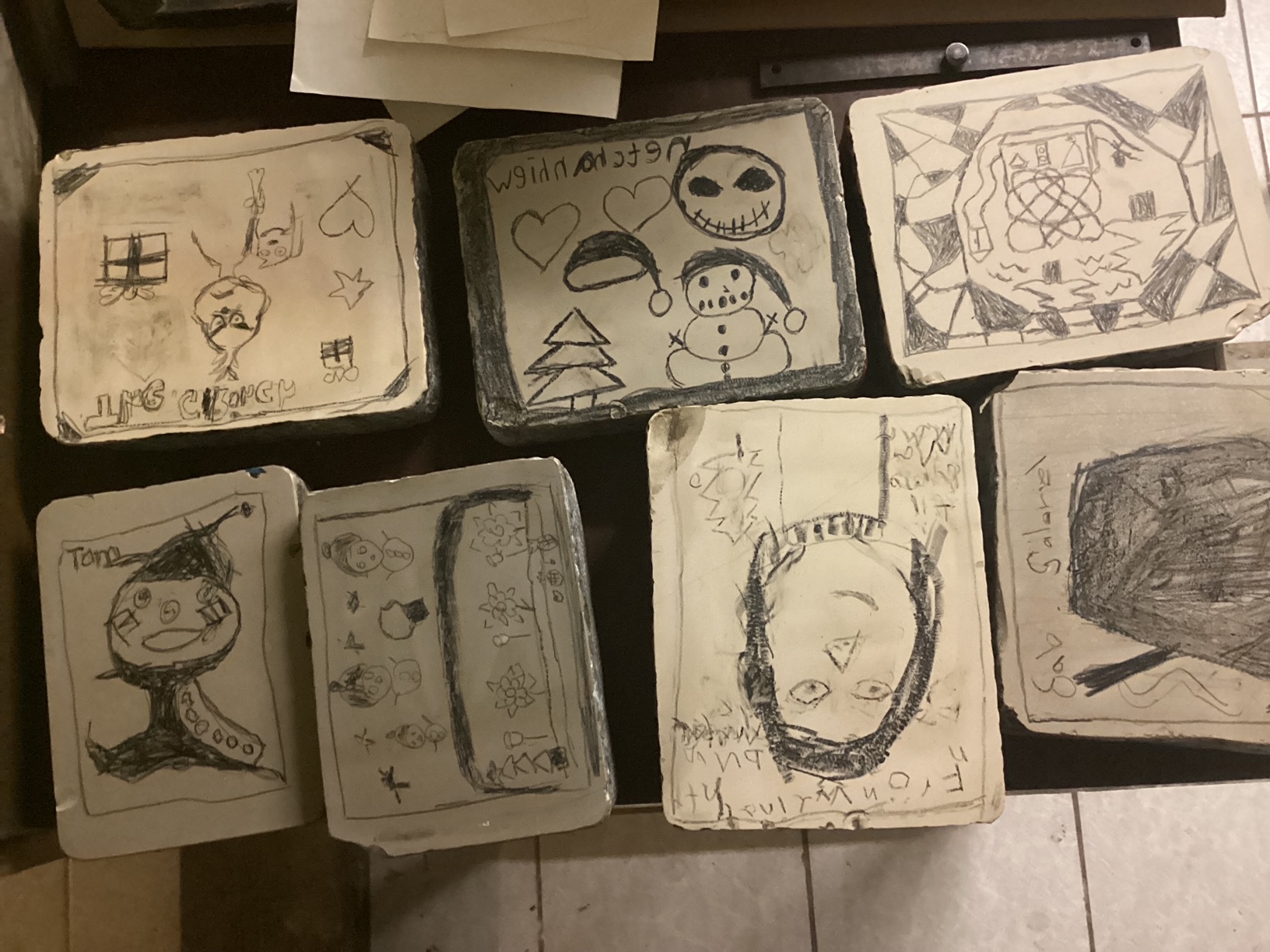
Over 4 days in November 2024, I taught 4 groups of 4th grade students the craft of lithography and etching in my workshop and studio. In lithography, the so-called flat printing, the pupils learned how to grind, mark and print the stone. In this way, they got to know an old craft that is still used artistically today. In intaglio printing, a drypoint etching and an etching were created.
The pupils were able to print their etchings independently under professional guidance and thus gained an insight into how artistic graphics are created.
At the end of the project, a joint exhibition was held at the school. Everyone was given their own works to take home with them.
Artistic director: Petra Reichenbach
Sekundarschule J.-W.-v.Goethe in Ilsenburg
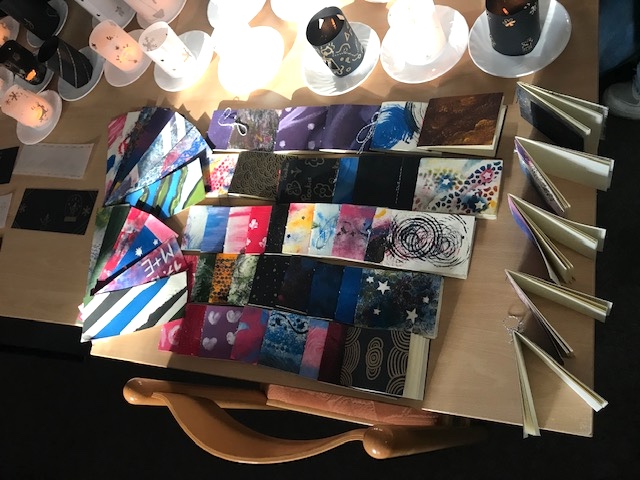
We began by discovering the ornamental diversity of the Ilsenburg monastery church.
Cardboard strips are printed with pattern rolls and stencils. They are used as covers for self-stitched sketchbooks.
For lanterns made of transparent paper and dark cardboard, further ornaments are engraved, cut, painted and stippled.
A visit to the current BBK exhibition “generell frisch” (generally fresh) at Ilsenburg Monastery was followed by our own final pre-Christmas exhibition in the vicarage.
Artistic director: Reneé Reichenbach
Levana School, Eisleben
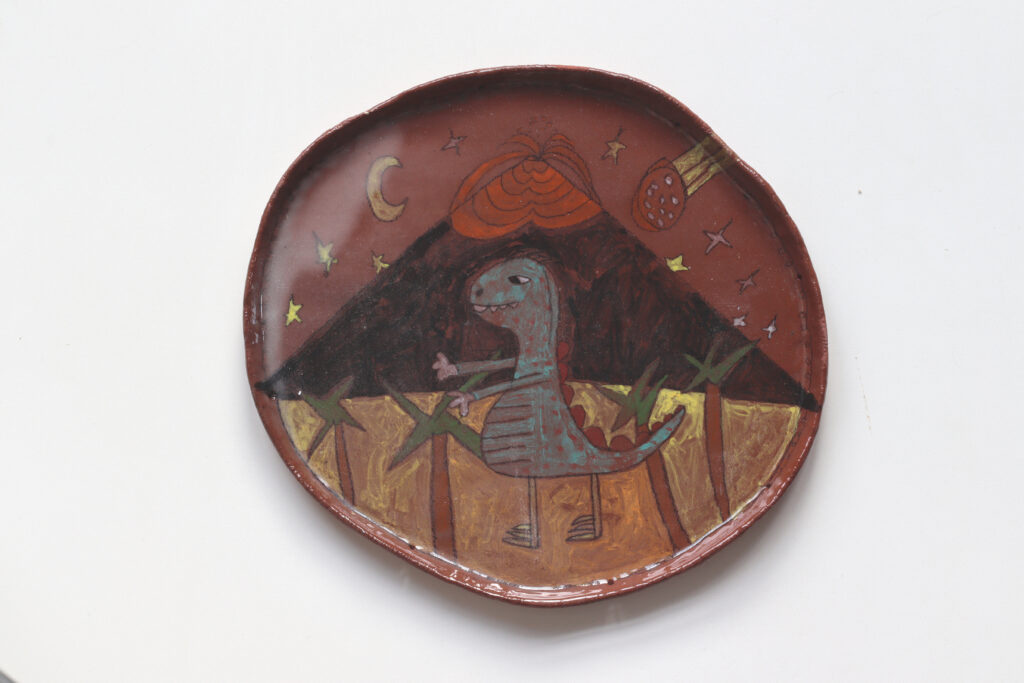
The project from last year was continued for a planned wall design in the school building of the Levana School in Eisleben:
The students painted ceramic plates made of different colored clays with engobes or, analogous to painting on paper, with special ceramic pens and ink pots. Each student was free to choose their own medium and motif. This resulted in portraits, depictions of animals, stories on clay, small insights into the imaginative inner pictorial world of the pupils.
Artistic director: Katrin Röder
Montessori School Halle
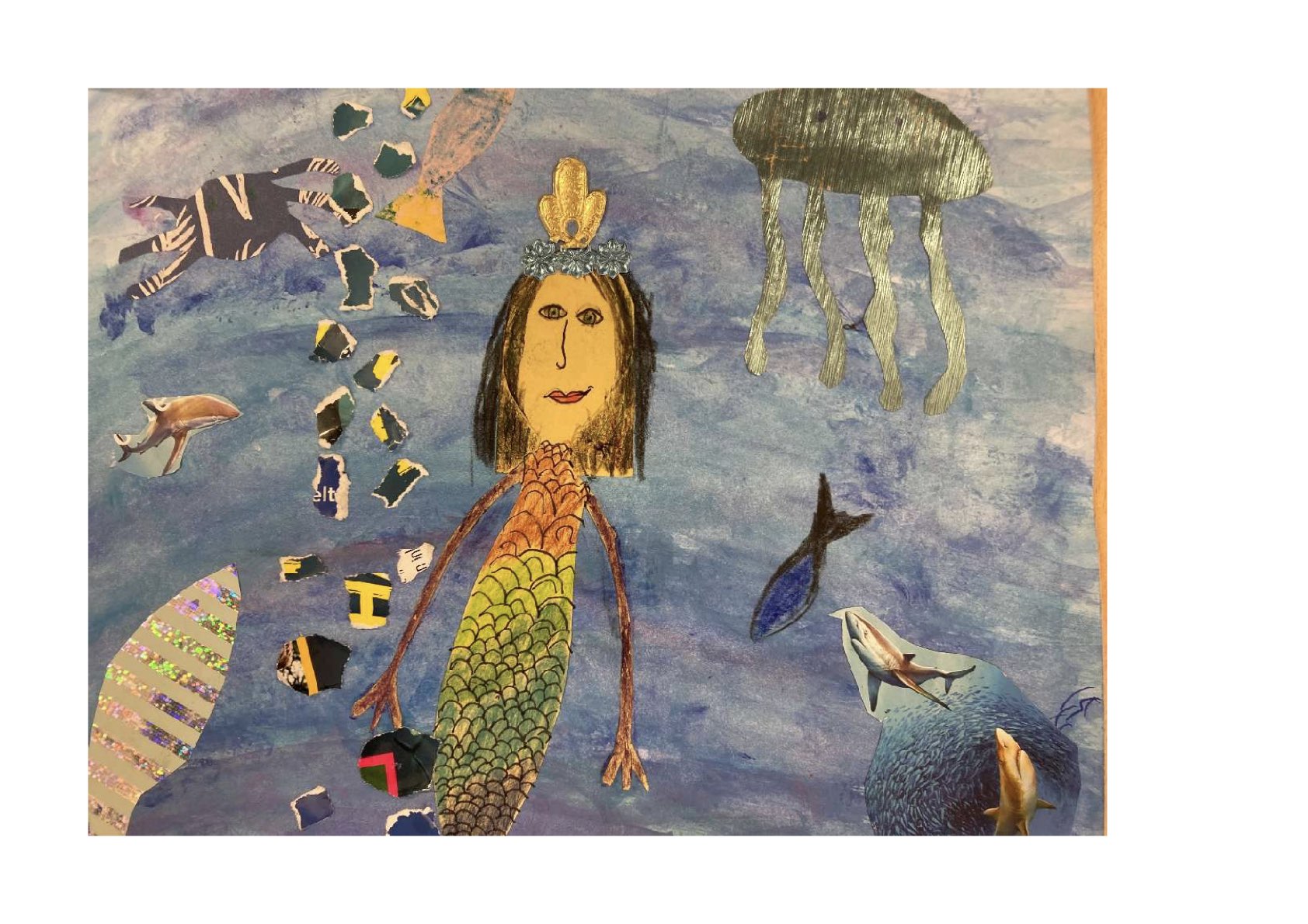
The aim was to work on the topic of the Saalenixe. To begin with, we read the legend “How the Saale got its name” and talked about mythical creatures and their history. Amazing experiences were heard on the subject of diving!
A collage was created in conjunction with a special printing technique. In several steps, the background was designed in several colors, the figure of the mermaid was created and sea creatures and plants were cut out using various papers. Graphic elements were also added using colored pencils, oil pastels and fineliners.
Artistic director: Desiree Sander
Kastanienallee Community School in Halle

To accompany the lessons, we spent seven weeks at Passage 13 in Halle-Neustadt working intensively on the topic of ‘digital storytelling’. This involved developing stories that were creatively implemented using a wide variety of media.
The process began with a simple postcard, which served as a starting point for initial ideas. Step by step, the children developed their own narratives using storytelling techniques and theater exercises.
The program was supplemented by practical experience in image composition and camera work. Intensive teamwork resulted in three short films that impressively demonstrated both the children’s creativity and their enthusiasm for storytelling.
Artistic director: Anke Späth
Primary School Henningen Salzwedel
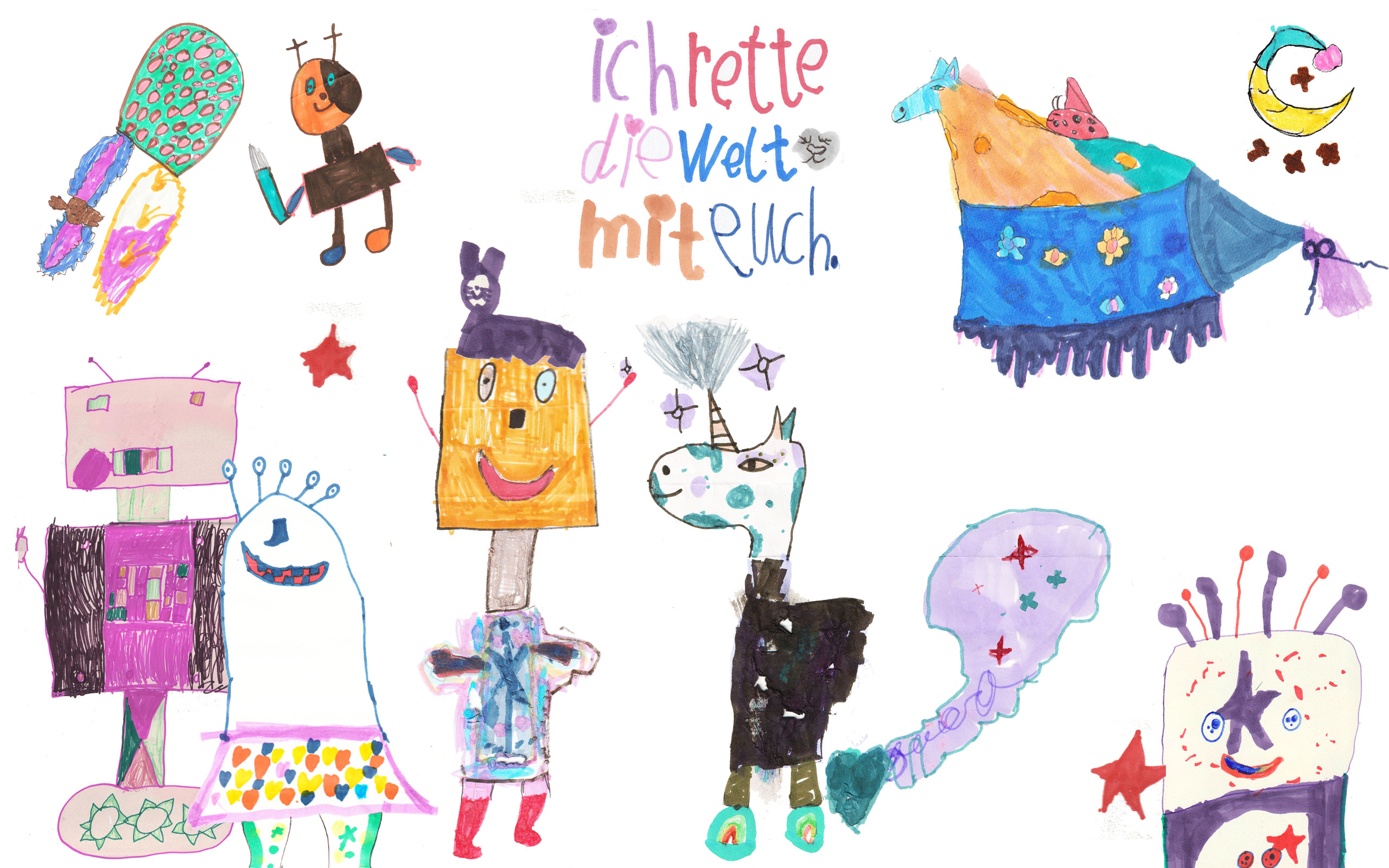
The children in second grade developed lots of great ideas on the subject of robots and aliens in space and their view of Earth.
We playfully created a concept in order to realize it in different materials and techniques according to the wish list and later put it together to form a large whole.
By changing their perspective, the children developed a different view of the earth.
Artistic director: Pauline Ullrich
Oppin Primary School
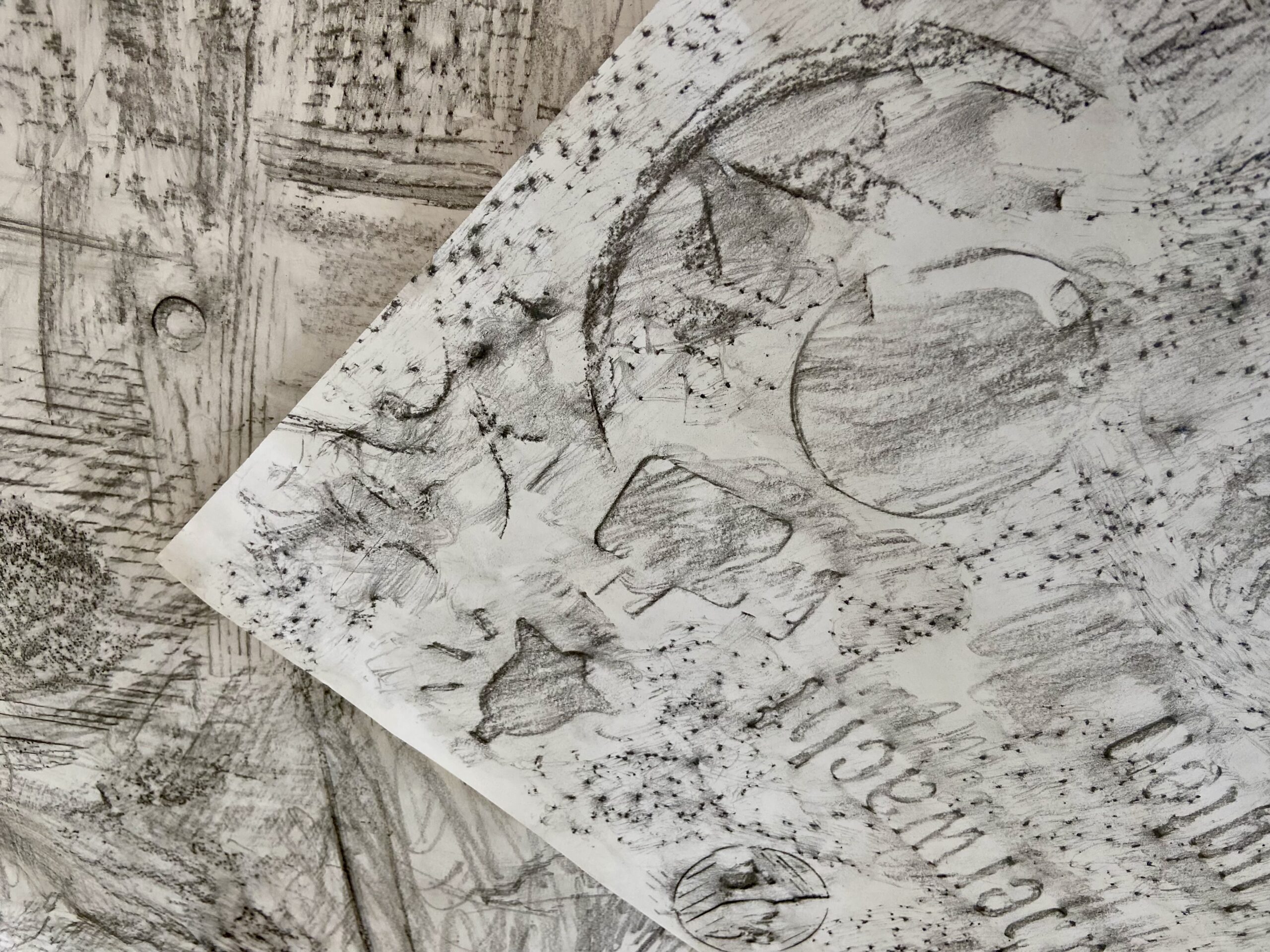
The Dream Eater – the basis for the school project with grades one and two was the classic children’s book by Michael Ende.
Some of the children found the nightmares much more exciting than the figure of the dream eater. During the project, a wide variety of moving figures were created using frottage and collage – the shapes derived from frottage gave these dreams, nightmares and dream eaters their special appearance in terms of shape and structure.
Artistic director: Grit Wendelberger
Grundschule Diemitz/Freiimfelde Halle (Saale)
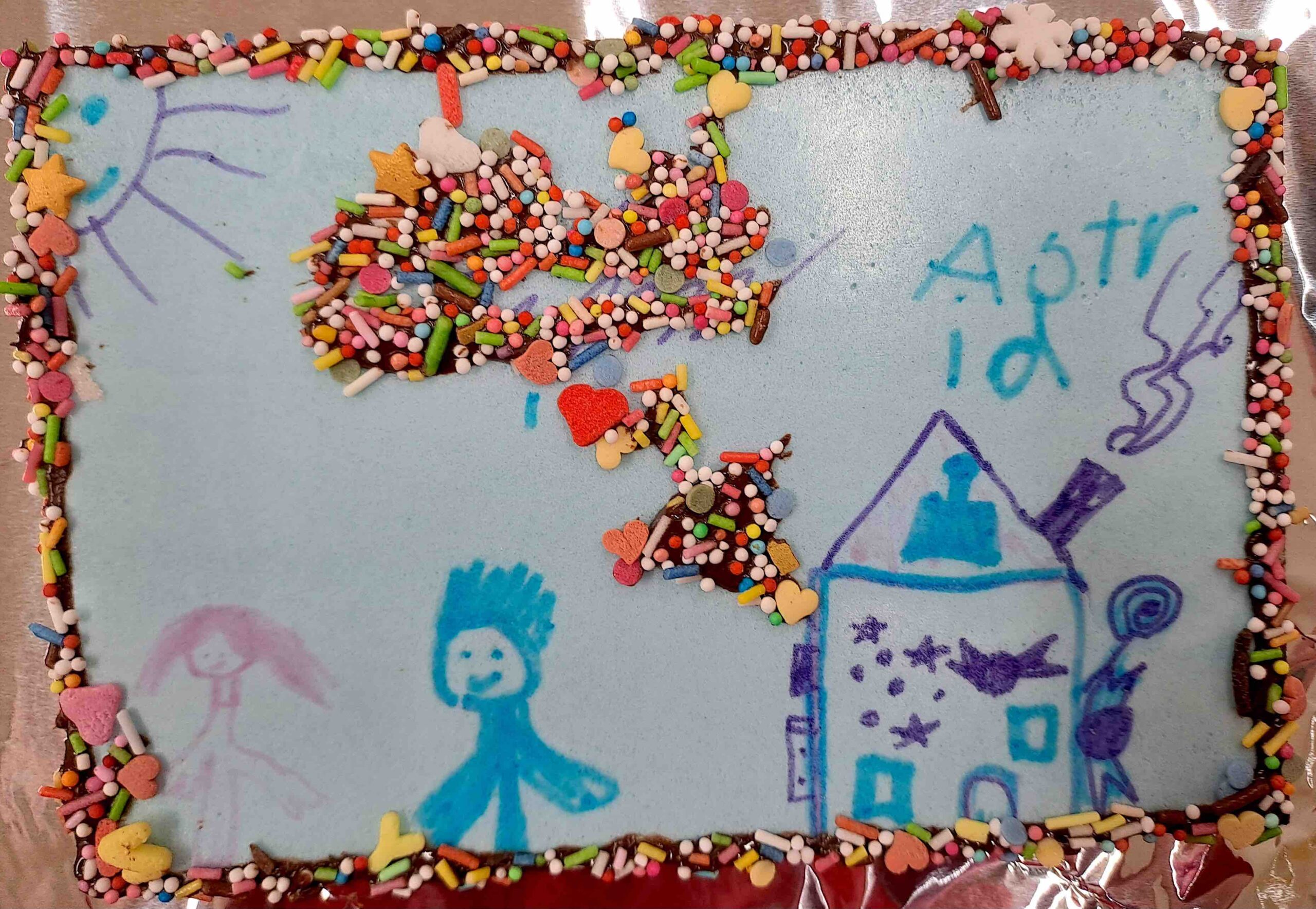
The 37 pupils from first to fourth grade experienced culinary creative Advent days: on the theme of “Eat Art”, they discovered basic techniques in dealing with the plastic chocolate paint: gluing, collaging, painting, shaping.
They created delicious miniatures on edible paper, cookies and chocolates based on the fairy tale Hansel and Gretel, as well as free works that will be beautifully packaged in self-designed bags for immediate consumption or to decorate the Christmas table.
The children cast sayings as chocolates and designed these and various cookies using basic serial shapes. They formed new relief-like creatures from Santas. They were inspired by fairy tales, sweet plates and the Christmas spirit.
Artistic director: Katrin Zickler
Gymnasium Philanthropinum Dessau
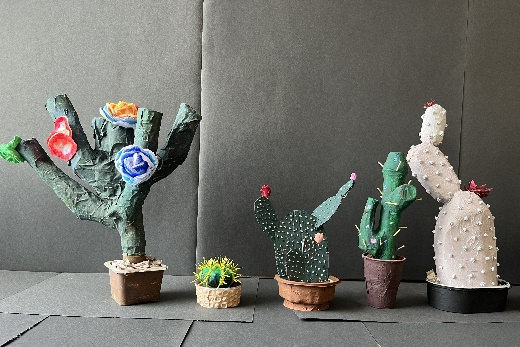
After a short drawing warm-up exercise with charcoal, the participants approached the motif graphically. Initially, the focus was on experimental drawings of cacti. With the help of self-made drawing aids and drawing ink, large-format works with an expressive character were created.
After inspecting the prepared pool of everyday materials, they then began quite intuitively to combine materials of different shapes and structures. The first blanks were created, which were then covered with tissue paper, for example, to prepare them for painting.
In the meantime, the idea came up to create a sculptural group work. This resulted in 24 small “seedlings”, which were put together as a joint work.
Artistic director: Ines Zimmermann
“Levana” special school in Lutherstadt Eisleben
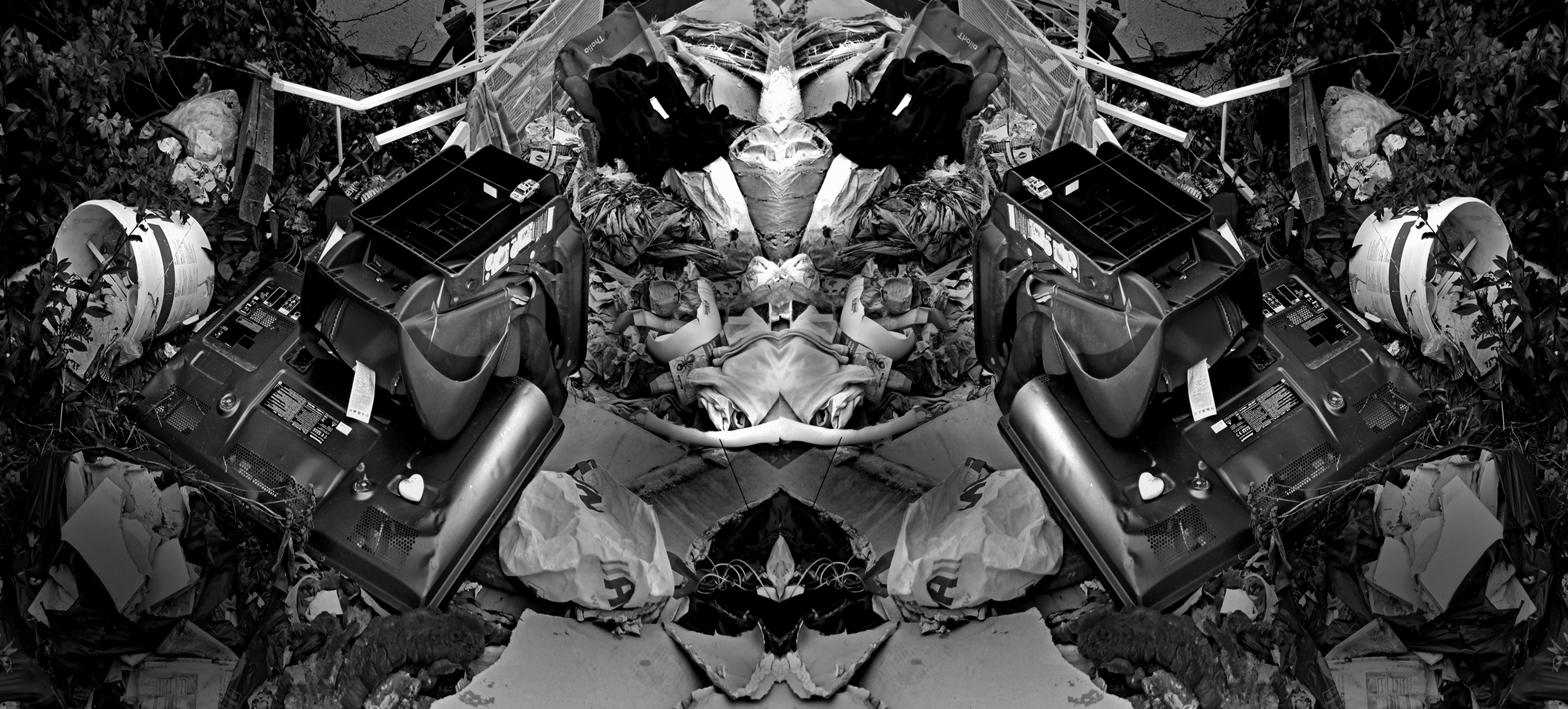
A photo project entitled “Garbage Life” (based on “Still Life”) took place at the Levana Special School for GB in Eisleben.
The garbage dump behind the school provided many motifs. Cheerful scenes were created by adding toy cars and figures. Some objects were illuminated with a flashlight so that their former beauty became visible again.
The photographs were taken with an SLR camera, interchangeable lenses, close-up lenses, a tripod and a cable release. The images were then processed on the computer.
